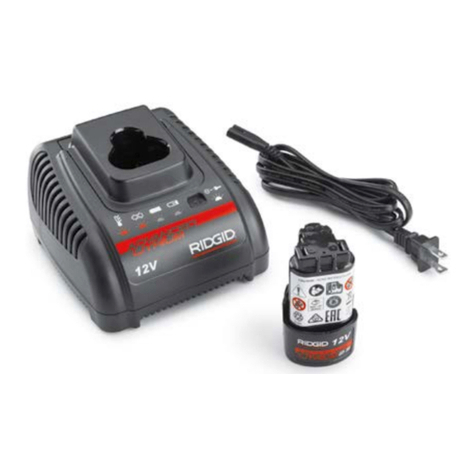RIDGID R86093 User manual

OPERATOR’S MANUAL
BATTERY CHARGER
MANUEL D’UTILISATION
CHARGEUR DE PILES
MANUAL DEL OPERADOR
CARGADOR DE BATERÍA
R86093
WARNING:
To reduce the risk of injury, the
user must read and understand
the operator’s manual before
using this product.
AVERTISSEMENT :
Pour réduire les risques de
blessures, l’utilisateur doit lire
et veiller à bien comprendre
le manuel d’utilisation avant
d’utiliser ce produit.
ADVERTENCIA:
Para reducir el riesgo de
lesiones, el usuario debe leer
y comprender el manual del
operador antes de usar este
producto.
SAVE THIS MANUAL FOR
FUTURE REFERENCE
GUARDE ESTE MANUAL
PARA FUTURAS CONSULTAS
CONSERVER CE MANUEL
POUR FUTURE RÉFÉRENCE
To register your RIDGID
product, please visit:
http://register.RIDGID.com
Pour enregistrer votre
produit de RIDGID,
s’il vous plaît la visite :
http://register.RIDGID.com
Para registrar su producto de
RIDGID, por favor visita:
http://register.RIDGID.com
Safety Rules for Charger .................2-3
Symbols..............................................3
Assembly............................................4
Operation.........................................4-5
Maintenance.......................................6
Illustrations .........................................7
Parts Ordering/Service........Back page
Règles de sécurité
pour le chargeur..............................2-3
Symboles............................................3
Assemblage........................................4
Utilisation.........................................4-5
Entretien .............................................6
Illustrations .........................................7
Commande de pièces
et réparation......................Page arrière
Reglas de seguridad para
el empleo del cargador...................2-3
Símbolos............................................ 3
Armado.............................................. 4
Funcionamiento..............................4-5
Mantenimiento................................... 6
Ilustraciones ...................................... 7
Pedidos de piezas
y servicio........................Pág. posterior
TABLE OF CONTENTS
****************
TABLE DES MATIÈRES
****************
ÍNDICE DE CONTENIDO
****************

2 — English
SAFETY RULES FOR CHARGER
Keep cord and charger from heat to prevent damage
to housing or internal parts.
Do not let gasoline, oils, petroleum-based products,
etc. come in contact with plastic parts. They contain
chemicals that can damage, weaken, or destroy
plastic.
Always wear eye protection with side shields marked
to comply with ANSI Z87.1. Failure to do so could result
in objects being thrown into your eyes resulting in possible
serious injury.
An extension cord should not be used unless
absolutely necessary. Use of improper extension cord
could result in a risk of fire and electric shock. If extension
cord must be used, make sure:
a. That pins on plug of extension cord are the same
number, size and shape as those of plug on charger.
b. That extension cord is properly wired and in good
electrical condition; and
c. That wire size is large enough for AC ampere rating
of charger as specified below:
Cord Length (Feet) 25' 50' 100'
Cord Size (AWG) 16 16 16
NOTE: AWG = American Wire Gauge
Do not operate charger with a damaged cord or plug,
which could cause shorting and electric shock. If damaged,
have the charger replaced by an authorized serviceman.
Do not operate charger if it has received a sharp blow,
been dropped, or otherwise damaged in any way.
Take it to an authorized serviceman for electrical check
to determine if the charger is in good working order.
Do not disassemble charger. Take it to an authorized
serviceman when service or repair is required. Incorrect
reassembly may result in a risk of electric shock or fire.
Unplug charger from outlet before attempting any
maintenance or cleaning to reduce the risk of electric
shock.
Disconnect charger from the power supply when
not in use. This will reduce the risk of electric shock or
damage to the charger if metal items should fall into the
opening. It also will help prevent damage to the charger
during a power surge.
Risk of electric shock. Do not touch uninsulated portion
of output connector or uninsulated battery terminal.
Save these instructions. Refer to them frequently and
use them to instruct others who may use this tool. If you
loan someone this tool, loan them these instructions also
to prevent misuse of the product and possible injury.
WARNING!
READ AND UNDERSTAND ALL INSTRUCTIONS.
Failure to follow all instructions listed below, may
result in electric shock, fire and/or serious personal
injury.
Before using charger, read all instructions and cautionary
markings in this manual, on charger, battery, and product
using battery to prevent misuse of the products and
possible injury or damage.
WARNING:
Charge only lithium-ion rechargeable batteries.
Other types of batteries may burst, causing
personal injury, fire, or damage. For compatible
battery packs see tool/appliance/battery pack/
charger correlation supplement 988000-302.
Do not use charger outdoors or expose to wet or damp
conditions. Water entering charger will increase the risk
of electric shock.
WARNING:
Do not charge a battery that is wet or has been wet
or exposed to liquids.
Use of an attachment not recommended or sold by the
battery charger manufacturer may result in a risk of
fire, electric shock, or injury to persons. Following this
rule will reduce the risk of electric shock, fire, or serious
personal injury.
Do not charge battery in a damp or wet location. Do
not use, store, or charge battery packs or products
in locations where the temperature is less than 50°F
or more than 84°F. Do not store outside or in vehicles.
Do not abuse cord or charger. Never use the cord to
carry the charger. Do not pull the charger cord rather than
the plug when disconnecting from receptacle. Damage
to the cord or charger could occur and create an electric
shock hazard. If cord or charger is damaged, have the
charger replaced by an authorized serviceman.
Make sure cord is located so that it will not be stepped
on, tripped over, come in contact with sharp edges
or moving parts or otherwise subjected to damage or
stress. This will reduce the risk of accidental falls, which
could cause injury, and damage to the cord, which could
result in electric shock.

3 — English
SAFETY RULES FOR CHARGER
IMPORTANT SAFETY INSTRUCTIONS
1. SAVE THESE INSTRUCTIONS - DANGER: TO REDUCE RISK OF FIRE
OR ELECTRIC SHOCK CAREFULLY FOLLOW THESE INSTRUCTIONS.
This manual contains important safety and operating instructions for battery charger R86093.
2. Before using battery charger, read all instructions and cautionary markings on battery charger, battery, and product
using battery.
3. CAUTION: To reduce the risk of injury, charge only lithium-ion rechargeable batteries. Other types of batteries
may burst, causing personal injury or damage.
SYMBOLS
Some of the following symbols may be used on this product. Please study them and learn their meaning. Proper
interpretation of these symbols will allow you to operate the product better and safer.
SYMBOL NAME DESIGNATION/EXPLANATION
Safety Alert Indicates a potential personal injury hazard.
Read Operator’s Manual To reduce the risk of injury, user must read and understand
operator’s manual before using this product.
Eye Protection Always wear eye protection with side shields marked to comply
with ANSI Z87.1.
Wet Conditions Alert Do not expose to rain or use in damp locations.
Wet Conditions Alert Risk of fire and burns. Do not expose battery, battery compartment,
or electronic components to rain, water, or liquids.
V Volts Voltage
Hz Hertz Frequency (cycles per second)
W Watt Power
Alternating Current Type of current
Direct Current Type or a characteristic of current
The following signal words and meanings are intended to explain the levels of risk associated with this product.
SYMBOL SIGNAL MEANING
DANGER: Indicates a hazardous situation, which, if not avoided, will result in death or
serious injury.
WARNING: Indicates a hazardous situation, which, if not avoided, could result in death or
serious injury.
CAUTION: Indicates a hazardous situation, that, if not avoided, may result in minor or
moderate injury.
NOTICE:(Without Safety Alert Symbol) Indicates information considered important, but
not related to a potential injury (e.g. messages relating to property damage).

4 — English
OPERATION
WARNING:
Do not allow familiarity with products to make you
careless. Remember that a careless fraction of a
second is sufficient to inflict serious injury.
WARNING:
Always wear eye protection with side shields
marked to comply with ANSI Z87.1. Failure to do
so could result in objects being thrown into your
eyes resulting in possible serious injury.
APPLICATIONS
You may use this product for the following purpose:
Charging compatible RIDGID™18 Volt battery packs
NOTICE:
If at any point during the charging process none
of the LEDs are lit, remove the battery pack from
the charger to avoid damaging the product. DO
NOT insert another battery. Return the charger and
battery to your nearest authorized service center
for service or replacement.
NOTICE:
Charge in a well-ventilated area.
KEY HOLE HANGER
See Figure 1, page 7.
The charger has a key hole hanging feature for convenient,
space saving mounting. Screws should be installed so that
the center distance is 1-1/2 in.
CHARGING
See Figure 2, page 7.
Battery packs are shipped in a low charge condition to
prevent possible problems. Therefore, you should charge
them before first use. If the charger does not charge your
battery pack under normal circumstances, return both the
battery pack and charger to your nearest repair center for
electrical check.
Charge time varies and is dependent upon the amp hour
capacity and charge level of the battery pack.
Make sure the power supply is normal household voltage,
120 volts, AC only, 60 Hz.
Connect the charger to a power supply.
Attach the battery pack to the charger by aligning the
raised ribs on the battery pack with the grooves in the
charger, then slide the battery pack onto the charger.
Press down on the battery pack to be sure contacts on
the battery pack engage properly with contacts in the
charger.
Do not place the charger in an area of extreme heat or
cold. It will work best at normal room temperature.
The battery pack may become slightly warm to the touch
while charging. This is normal and does not indicate a
problem.
After charging is complete, the green LED will remain on.
When the battery pack is fully charged, remove it from
the charger.
ASSEMBLY
WARNING:
Do not use this product if it is not completely
assembled or if any parts appear to be missing or
damaged. Use of a product that is not properly and
completely assembled or with damaged or missing
parts could result in serious personal injury.
WARNING:
Do not attempt to modify this product or create
accessories or attachments not recommended
for use with this product. Any such alteration
or modification is misuse and could result in a
hazardous condition leading to possible serious
personal injury.
If any parts are damaged or missing, please call 1-866-539-1710 for assistance.

5 — English
OPERATION
NOTE: Maintenance information begins on page 6 after French and Spanish
language sections. Illustrations start on page 7.
This product has a 90-Day Satisfaction Guarantee Policy, as well as a
Three-year Limited Warranty. For Warranty and Policy details, please go to
www.RIDGID.com or call (toll free) 1-866-539-1710.
LED FUNCTIONS
See Figure 2, page 7.
MODE
LEDs
Charging/Full Temp. delay Error
LED Green Orange Red
EVALUATE Off Flashing Off
CHARGING Flashing Off Off
FULLY CHARGED On Off Off
TEMP. ERROR Off On Off
• Hot battery pack: When battery pack reaches cooled temperature, charger begins charge mode.
• Cold battery pack: When battery pack warms, charger begins charge mode.
• Deeply discharged: Charger conditions battery until normal voltage is reached, then begins charge mode.
STANDBY FULL On Off Off
STANDBY POWER
(Battery pack not inserted) On Off Off
ERROR Off Off On
• Try to repeat the conditions a second time by removing and reinstalling the battery pack. If the LED Error status
repeats a second time, try charging a different battery.
• If a different battery charges normally, dispose of the pack that received the Error (see your battery pack manual for
instructions).
• If a different battery also indicates ERROR, the charger should be replaced.
CHARGING A HOT BATTERY PACK
When using a tool continuously, the battery pack may
become hot. A hot battery pack may be placed directly onto
the charger port but charging will not begin until the battery
temperature cools to within acceptable temperature range.
When a hot battery pack is placed on the charger, the orange
LED will begin flashing and the green LED will be off. When
the battery pack cools, the charger will automatically begin
charging.
CHARGING A COLD BATTERY PACK
A cold battery pack may be placed directly onto the charger
port but charging will not begin until the battery temperature
warms to within acceptable temperature range. When a cold
battery pack is placed on the charger, the orange LED will
begin flashing and the green LED will be off. When the battery
pack warms, the charger will automatically begin charging.
Table of contents
Languages:
Other RIDGID Batteries Charger manuals
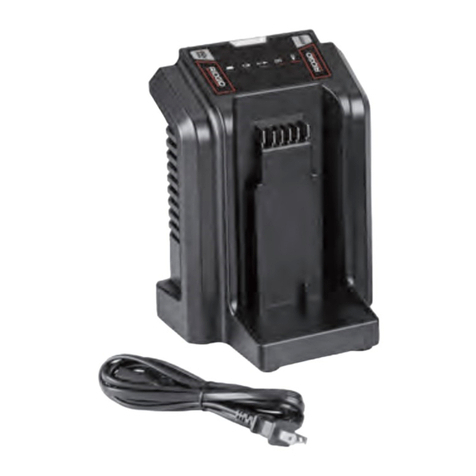
RIDGID
RIDGID RBC-FXP User manual
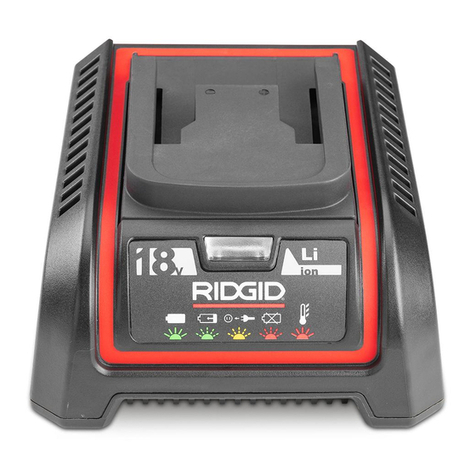
RIDGID
RIDGID RBC-30 User manual

RIDGID
RIDGID RBC-30 User manual

RIDGID
RIDGID R86049 User manual

RIDGID
RIDGID RBC 20 User manual
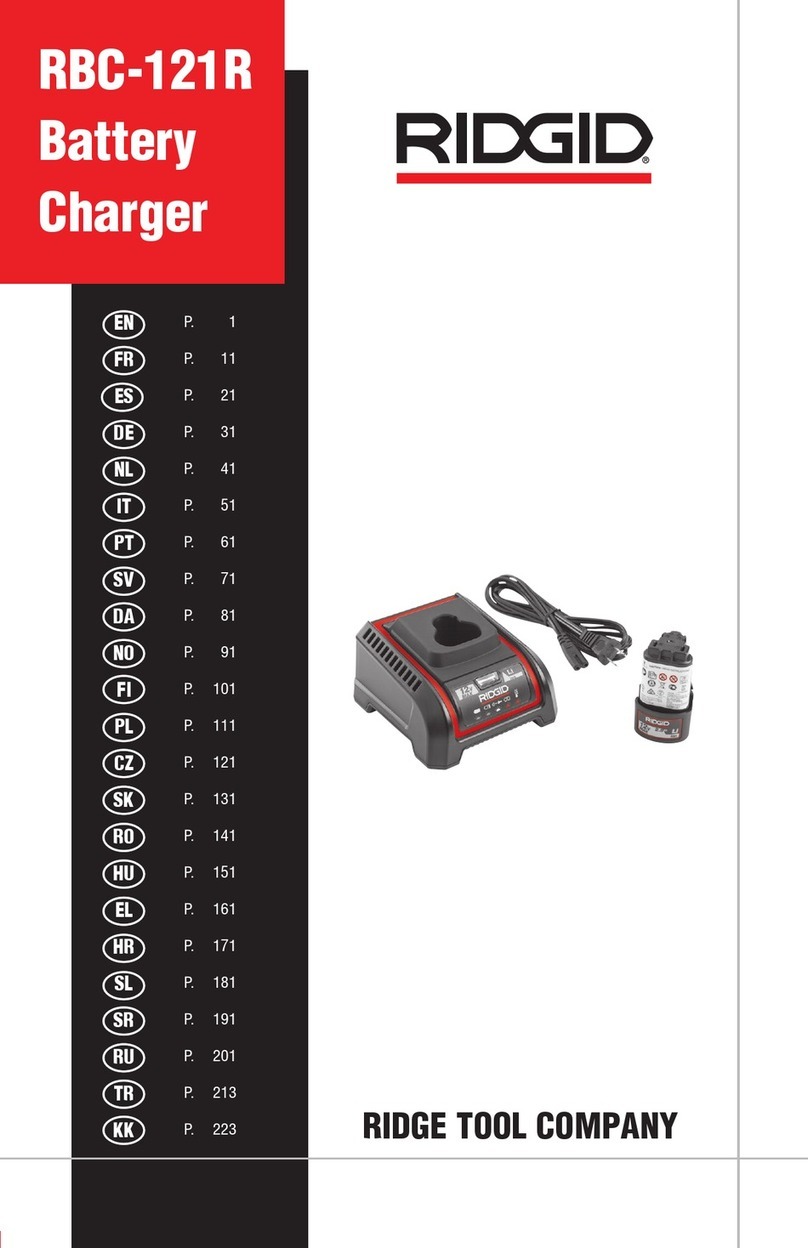
RIDGID
RIDGID RBC-121R User manual
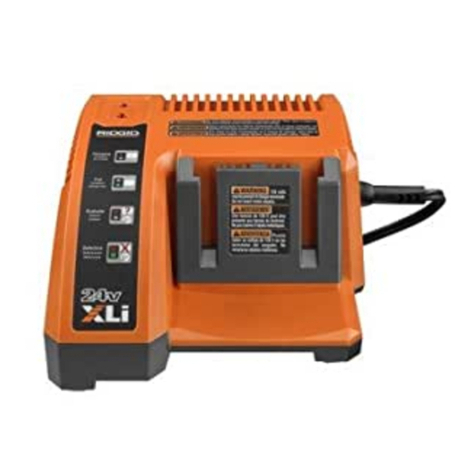
RIDGID
RIDGID R85009 User manual
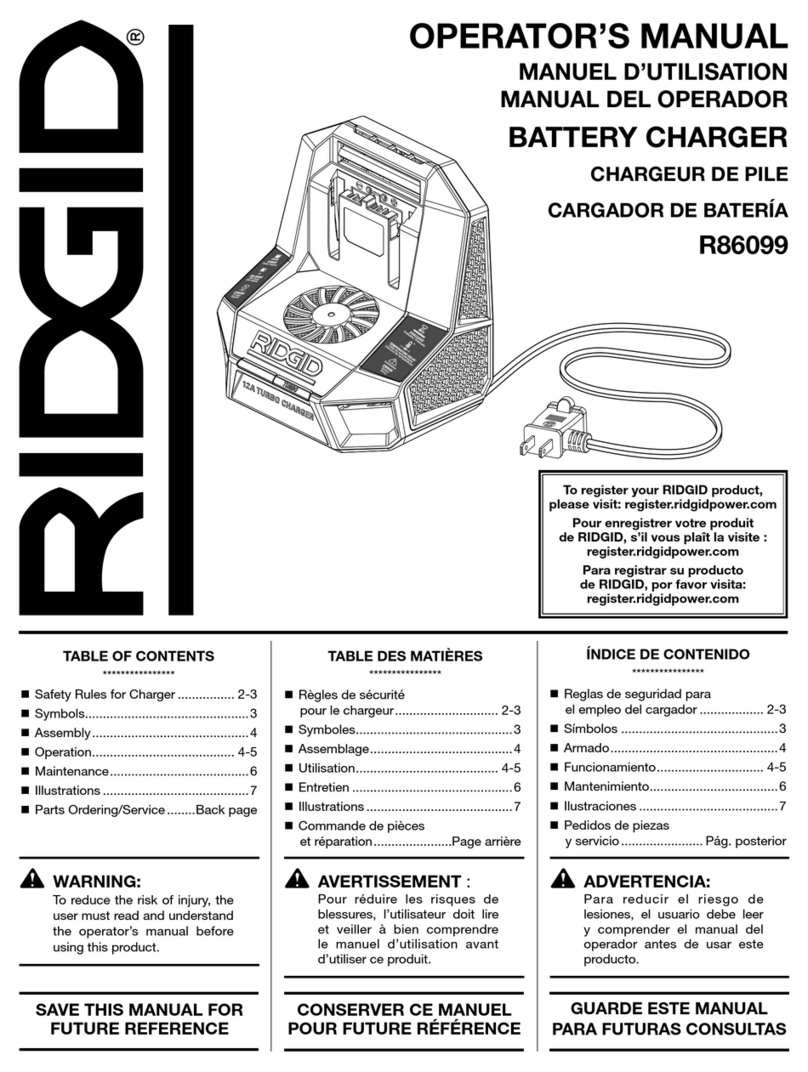
RIDGID
RIDGID R86099 User manual
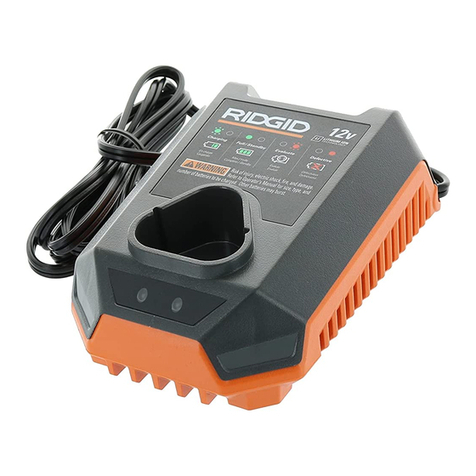
RIDGID
RIDGID R86045 User manual
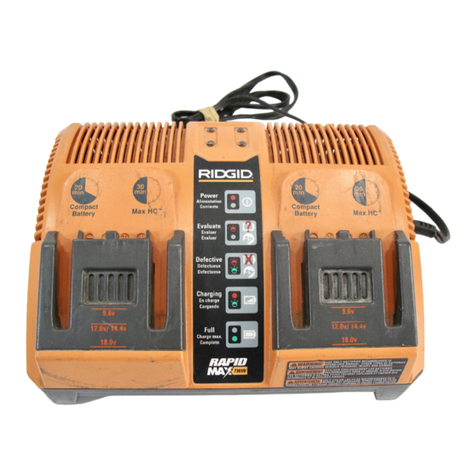
RIDGID
RIDGID 140276004 User manual
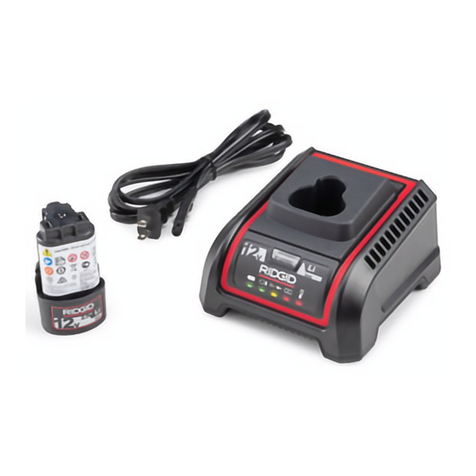
RIDGID
RIDGID RBC-121R User manual

RIDGID
RIDGID RBC-121R User manual
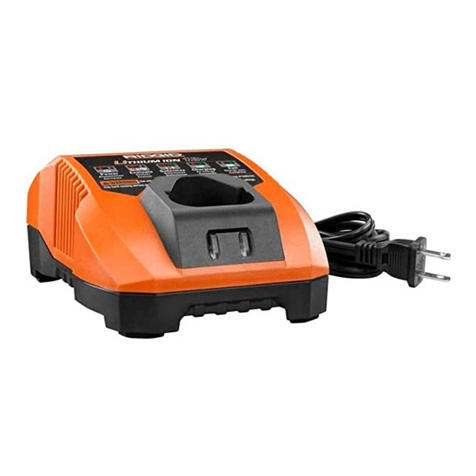
RIDGID
RIDGID R86049 User manual

RIDGID
RIDGID RBC 10 User manual
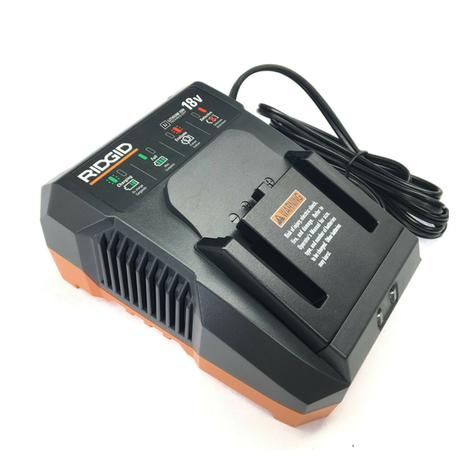
RIDGID
RIDGID R86092 User manual
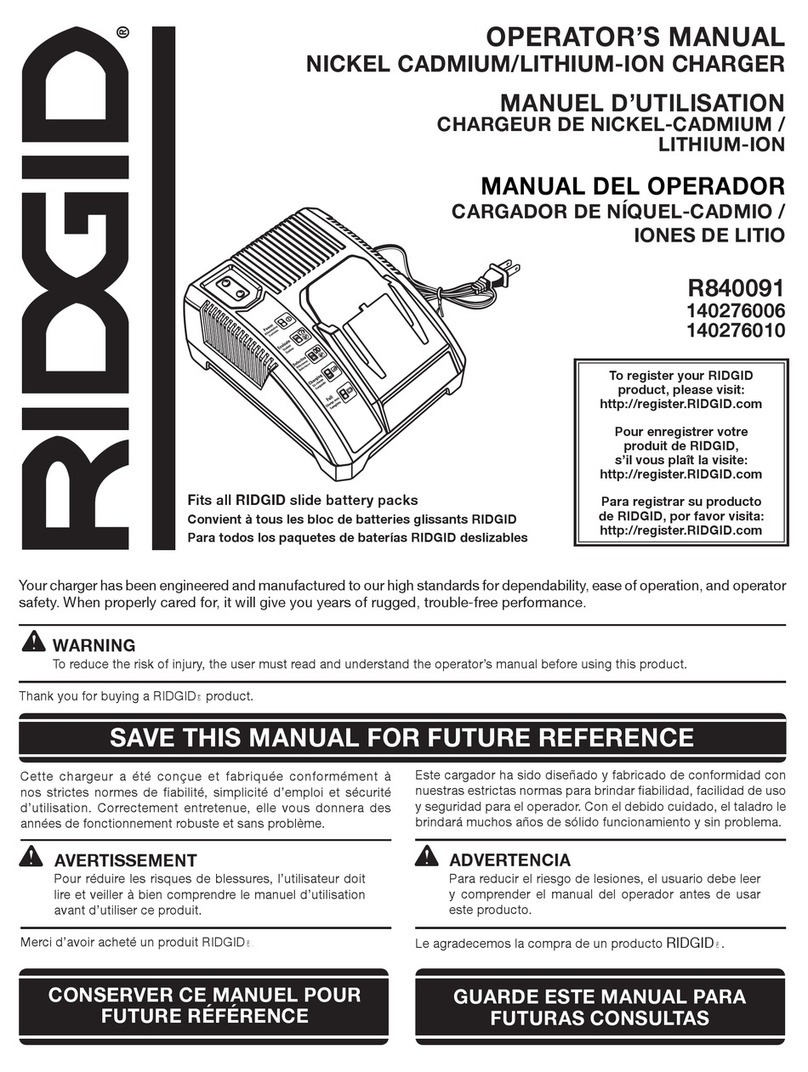
RIDGID
RIDGID R840091 User manual
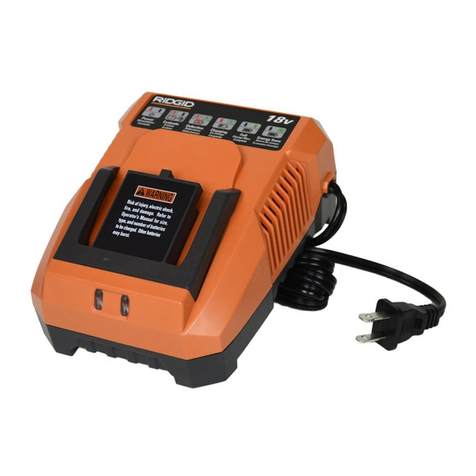
RIDGID
RIDGID R86091 User manual
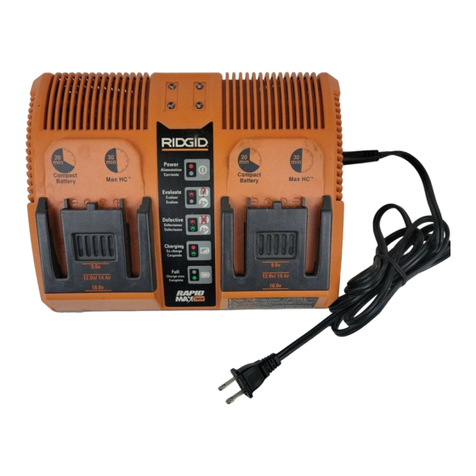
RIDGID
RIDGID 140276002 User manual

RIDGID
RIDGID R840095 User manual
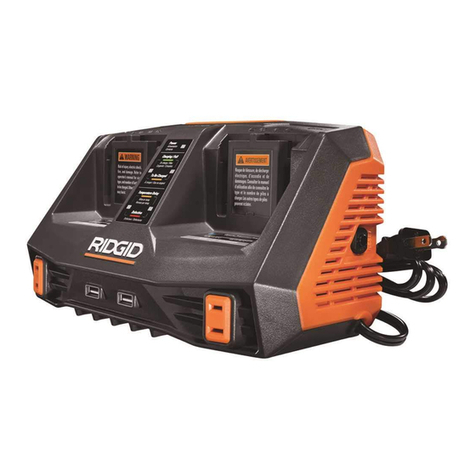
RIDGID
RIDGID R840094 User manual

